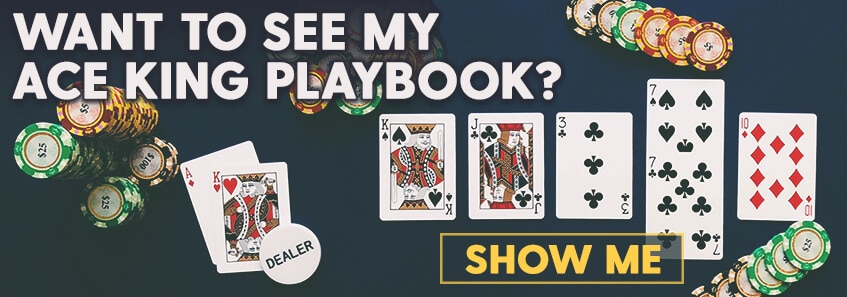Today we’re going to go through a quiz that I posted earlier on YouTube. First, thanks to Will for sending this hand in. Second, many thanks to everyone who responded to the quiz. Your participation is the only way I can make these things happen. And finally, thanks to those of you who spotted a math error in an earlier version of this video – I’ve since corrected it, re-recorded the video, and reuploaded it:
The hand is from live $1/$2. Will, a self-identified LAG who says he opens pretty much all of his buttons, opens on the button with T♠T♣. A nit in the big blind 3-bets to $22. Will says he’s confident he’s looking at JJ+/AK from this opponent and decides to call.
On the 9♥9♦2♦ flop, the nit decides NOT to continuation bet and Will fires an almost pot-sized bet. The turn is the 2♠ and Will follows through with another large bet when checked to. The river brings the 5♦ filling the flush draw and the nit once again checks.
So we have three options here as given by the quiz. We can:
- Check behind
- Bet $100 into $335
- Go all-in for $213 effective
So ask yourself what you would do in this spot before I give the results of the quiz.
The results were pretty much what I expected. 68% of you said you’d check behind, 22% that you’d go all-in, and the remaining 10% would bet $100. So let’s break down all three options.

Betting $100. I don’t really see what that option does. Do we get called by a bunch of extra second-best hands that wouldn’t call an all-in? I don’t think so. Does it create extra fold equity to JJ+? No. Basically this option neither maximizes fold equity nor gets action from worse hands.
So that leaves checking behind or going all-in. Will said in his write-up that shoving here is basically turning his hand into a bluff. So that raises the question, do we ever get overpairs to fold here? What is this bet actually doing and is it good or bad?
So let’s dig in to the math of the situation. For situations like this I created a bet versus check tool that you can download.
All we need to establish here is the value of checking versus the value of firing. Before doing that, I need to make an important point. The results of the math depend strongly on the assumptions we put into it concerning the ranges that will call and fold and how our hand does against the calling range. Some assumptions will lead to the clear conclusion that checking back is best here, and others will strongly point to going all in.
In other words, the math is a static framework. Our assumptions are variables that we plug into the formula.
So let’s think about some reasonable assumptions. Given that Villain is a nit, I think it’s inevitable he only gets to the river with an extremely strong range. If this is true, the nit is holding JJ+ and two flush combos and is never going to fold to our shove getting around 2.6-to-1.
So if these assumptions are correct we’re in an extreme situation where we’re always getting called when we shove and we always lose. And honestly, you don’t need a calculator to tell you that this is thus a losing bet. Clearly, the value of betting here is just the effective size of the shove of -$213.
That’s pretty bad, obviously, but what’s the value of checking back? We still always lose, but the EV of checking is simply $0. So with these assumptions, checking is far superior to shoving on this river.
But now let’s change the assumptions. Suppose the nit gets to the river with JJ+/AQ+ and never folds overpairs and flushes. Maybe when the board double pairs on the turn they decide to take one more off, which against Will who is a LAG and likely perceived on the bluff-heavy side of the spectrum might be reasonable.
I don’t necessarily agree with these assumptions, but let’s throw them on the calculator. So we still lose to the overpairs and the flushes, but let’s suppose the nit gets here with all of the AK and AQ combos. Two of those combos are flushes that beat us, but we beat the remaining 30 combinations. If we check back here, the calculator tells us our EV is a shade shy of $180.
Now we need to compare that to the EV of shoving in this spot. This requires us to make another assumption. Specifically, if we shove, is villain going to call with the non-flush AK and AQ? If no, then our opponent is only check-calling with hands that beat us. From the calculator, we find that when Villain folds the non-flush AK and AQ our EV is $83.
So with these assumptions, it turns out our highest EV is once again to check behind on the river. What this tells us is that in order for the river shove to be the more profitable play, we have to come up with assumptions such that we’re winning when called, and/or Villain is folding hands that have us beat.
Let’s look at the case when our shove folds out some of the overpairs. By playing with the calculator we find that we need Villain to have a pretty high river folding percentage before our shove becomes profitable. In my view that seems optimistic.
Three more takeaways before we wrap up.
First, one critique that GTO advocates may make of this analysis is the following. They would argue that from a GTO perspective we have to turn our hand into a bluff here sometimes. Cool your jets. We are dealing with a nit, and nits have a baked-in frequency-based problem. They get to the river with a super strong range that they are not folding. Against such players we exploit them by checking back, not by setting money on fire.
Second, there’s an interesting point raised by Will’s write-up. He says:
Since I opened my buttons so wide, and only called his 3-bet, I figured the flop nailed my range much more than the nit’s.
So let’s go back to the flop when the nit checks. I 100% agree Will can have some monsters here. T9 and 98 and A9 are all in his range. But Will’s wide button opening range also means he can have a huge number of combos that whiffed this flop. So sure you have more nutted combos that the nit, but that doesn’t mean the nit is going to rush to the fold button.
And this leads us to the third and major point. My preferred assumptions about the range the nit shows up with on the river are informed by the line and the bet sizing leading up to that point. These considerations are always fundamental to successful hand reading. So let’s review the play. Will’s raise-call preflop is completely standard. On the flop Will decides to fire a large c-bet. Same story on the turn. The bet size here is massive. Note in particular that this turn bet crosses the $100 threshold which is psychologically relevant, particularly in live games.
When a nit decides to call a $100+ bet at these limits, you should be petrified. Calling such a bet means a nit is serious about their hand, and if they are serious ab out it they’re probably not going to let it go on the next street.
So let’s look at another way this hand might have played out. What happens if Will bets smaller on the flop? This does two things. First, we can get called by a wider range. In the context of this hand and the likely preflop 3-bet range of the nit, we may keep in the AK and AQ. Further, if we get called on the flop we can fire a smaller bet on the turn. If we suspect we basically turning our hand into a bluff, this is a better situation for us.
In other words, by using smaller sizing, we set up different ranges and river pain points. On the river, we’ll have more money behind and may have a large enough shell to fire that will take the nit off hands that beat us. We’ll be laying the nit a worse price on the river with this larger bet which may give us the extra fold equity we need.
Again, thanks to Will for sharing this interesting hand and to all of you who participated in the quiz.

